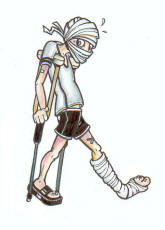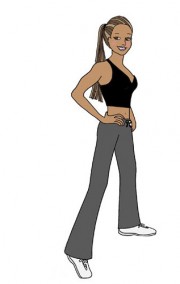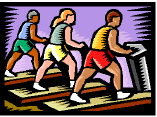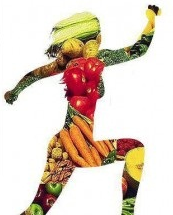 The following article is a small excerpt from one of my books. I hope you’ll want to learn more and let me help you to get into the best shape of your life.
The following article is a small excerpt from one of my books. I hope you’ll want to learn more and let me help you to get into the best shape of your life.

If you look up Fit in the dictionary it has several meanings. The one that is relevant here is Physical fitness, how well a person is suited for physical tasks. Not exactly helpful, as it doesn’t say anything about how many pushups you should be able to do or how much weight you should be able to lift or how fast you should be able to run.
In my book ‘Get fit Stay fit’, I show you several fitness tests that are guidelines as to where you are and what you should be able to do, to help you keep track of your performance and your progress.
Here are 10 simple but not easy things you should be able to do before you can say that you are “in shape.” The good news is if you don’t measure up to the high standards right away, there are tips and training strategies you can use to help you to obtain the high goals. If and when you accomplish all 10 goals, then you won’t need to look in a dictionary for the definition of fit, you’ll just have to look in the mirror.
10 Standards to Assess Your Fitness Level
1) Bench 1.5 Times Your Body Weight
Upper-body strength is important for more than bench-press bragging rights or looking great in a tank top.
The Test: Use a bench-press machine and keep your feet flat on the floor during the entire lift. To get your score, divide the heaviest weight you can lift one time by your body weight.
The Scorecard:
Less than 1.0: Weak
1.0-1.49: Ordinary
1.5 or more: You rule on the bench
Boost Your Bench Press: The key to strengthening any muscle is lifting fast. Using a weight that’s about 40 percent of what you can lift one time, do nine sets of three repetitions, with 60 seconds’ rest between sets. Lower and raise the bar as fast as possible, and alternate your grip every three sets, so that your hands are 16, then 20, then 24 inches apart.
Three days later, perform three sets of flat, incline, or decline barbell bench presses (alternate varieties each week) with the heaviest weight you can lift six times.
Bonus tip: Press your head into the bench as you lift. You’ll activate the muscles called neck extensors, which help ensure that your spine is in a straight line. That’ll put your body in a stronger position.
2) Run 1.5 Miles in 10 Minutes
Breaking the 10-minute mark for a mile and a half is an indicator of peak aerobic capacity, where your body is able to deliver oxygen to your working muscles. Regular aerobic exercise lowers your cholesterol and helps keep your body fat low, both of which significantly decrease your risk of heart disease.
The Test: Run 1 1/2 miles on a flat path as fast as you can.
The Scorecard:
12 minutes or more: Slow
Between 10 and 12 minutes: Ordinary
10 minutes or less: Endurance excellence
Air Out Your Aerobic Ability: To build aerobic capacity, you need to run far. But you also need to run fast.
Perform a 40- to 60-minute run on Saturday at a pace just slow enough that you never feel winded. (Walk if you need to.)
On Tuesday, do four to six half-mile intervals at your goal pace for the mile-and-a-half run. (If your goal is 10 minutes, run each interval in 3 minutes, 20 seconds.) Rest for the same amount of time as each interval takes.
On Thursday, perform four to six uphill runs at a moderate pace, with each lasting about 90 seconds, and take about 2 minutes’ rest after each interval. After your last interval, jog for 10 to 15 minutes at an easy pace.
Bonus Tip: Train like Roger Bannister. That is, split the distance into four 600-yard intervals and run them at a pace that’s about 10 percent faster than your 11/2-mile pace, resting 1 minute after each. Bannister used this method to train for the first sub-4-minute mile.
3) Touch the Rim
A good vertical leap is the ultimate sign of lower-body power. It means you can combine lower-body speed and strength into one quick movement. And that’ll help you anytime you need to move explosively.
( If the rim is out of reach, make the backboard your goal.)
The Test: You’ll need a small bag of chalk to do this test. Chalk your fingers and stand flat-footed next to a wall. Place your chalked hand as high as possible on the wall and mark it with your fingertips. Then, without taking a step, dip your knees, swing your arms up, and jump as high as you can, again marking the wall with your fingertips. The distance between the two marks is your vertical-jump height.
The Scorecard:
20 inches or less: Grounded
Between 20 and 26 inches: Ordinary
Higher than 26 inches: High flyer
Have Better Hops: To leap higher, you have to practice explosive jumps.
Stand on a box or step that’s about 12 inches high. Step off the box, and as soon as your feet hit the floor, jump as high as you can. Repeat five times.
Do four more sets, resting 30 seconds between sets.
Bonus Tip: Never use your first jump as your score. You can expect maximum air on your third attempt.
4) Leg-Press 2.25 Times Your Weight
When it comes to strength, your lower half is your better half. Your leg and butt muscles are the foundation of your body and essential for almost any activity, from standing upright to sprinting to pushing. Make your leg-press goal 400 pounds.
The Test: Assume the position in a leg-press machine. Lower the weight until your knees are bent 90 degrees, and then push the weight back up. To get your score, divide the highest amount of weight you can lift one time by your body weight.
The Scorecard:
Less than 1.8: A shaky foundation
1.8 to 2.2: Ordinary More than
2.2: Serious strength
Get Stronger Legs: Try this technique, called diminished-rest interval training. You’ll improve your leg-press performance by 10 to 20 percent in 3 weeks. Using a weight that’s about 95 percent of the amount you lifted in the test, perform 10 sets of one repetition, resting 80 seconds after each set.
Do this workout twice a week, each time reducing the rest period between sets by 10 seconds. When your rest period is down to 30 seconds, retake the test and increase the weight.
Bonus Tip: Right before you take the test, do a leg press with 20 percent more weight than what you think you can lift one time but lower the weight only halfway before pushing it back up. When you perform the test, your muscles will be expecting a heavier weight. It’ll not only seem easier, but you’ll be able to push more pounds.
5) Swim 700 Yards in 12 Minutes
Funny thing about swimming is that some people can run 26 miles without breathing hard, yet sink to the bottom of a pool after half a lap. Why? Because swimming requires both aerobic capacity and upper-body muscle
The Test: Swim as far as you can in 12 minutes. Your total distance in yards is your score.
The Scorecard:
Less than 500 yards: You’re sunk
500-700 yards: Ordinary
More than 700 yards: Aquatic excellence
Swim Better, Swim Farther: Only two out of 100 people swim well enough to complete a quarter of a mile without stopping. That’s usually because they have poor form.
Follow this rule: Keep your head aligned with your body (the way you hold it when you’re not in the water) the time you’re swimming. When you breathe, roll your entire body, as if you were breathing with your belly button, without changing the position of your head. You’ll float better and use less energy. And that means you’ll be able to swim farther.
Bonus Tip: Swim 25 yards at a time to practice your form. Start by swimming a total of 200 yards per session, eight 25-yard intervals. Add 50 yards each week until you’re swimming a total of at least 500 yards. Increase your intervals by 25 yards every 2 weeks until you’re able to swim the entire distance without stopping.
6) Do 40 Pushups
Pushups measure upper-body endurance, the ability to use your strength over time. If you can crank out 40 pushups, we guarantee that your body won’t quit when everything’s on the line.
The Test: Lower your body until your upper arms are parallel to the floor, then push yourself up. Repeat as many times as you can.
The Scorecard:
25 or fewer: Weak
26-39: Ordinary
40 or more: Strong and tough
Build an Upper Body for the Long Run: Try this program . Perform sets of half the number of pushups that you completed in the test, resting 60 seconds between sets, until you’ve done a total of 40 pushups. (For example, if you did 12 pushups in the test, you’ll do seven sets of six pushups.)
Each workout (do it every 4 days), deduct 5 seconds from the rest interval. After 12 workouts, you’ll be able to do 40 pushups without rest.
Bonus Tip: Time how long it takes you to do as many pushups as you can. Then rest for the same time period, and repeat the process two to four times. You’ll quickly improve your upper-body endurance.
7) Measure Up
The more fat your body stores in your midsection, the higher your risk of heart disease.
The Test: The easiest method of determining your risk level is a comparison of your waist and hip circumferences. Grab a measuring tape and measure the circumference of your waist at the narrowest point. Then measure the distance around the widest part of your hips and butt. Divide your waist circumference by your hip circumference for your score.
The Scorecard:
0.92 or higher: not good
0.82 to 0.91: Ordinary
0.81 or less: Flat and happy
Shrink Your Belly: A combination of diet and exercise will help you lose weight the fastest..
Try this simple method to make the transition from chip eater to healthy. Cut 250 calories from your diet and burn 250 calories a day through exercise. That’s a total of 500 calories, enough to lose a pound a week.
250 calories is about the same as a 20-ounce Coke, a small bagel, or two handfuls of potato chips. To burn the same number of calories through exercise, a 180-pound man could lift weights for 30 minutes, walk 2 1/2 miles, or play basketball for 20 minutes.
Bonus Tip: Limit your carbohydrates, especially the high-sugar kind after 5 p.m. Research shows that as the day progresses, your body has a greater potential to store them as fat.
8) Run 300 Yards Sub 1 Minute
If you can cover 300 yards in 60 seconds, you have the speed and drive you need for just about anything.
The Test: Run as fast as you can between two lines spaced 25 yards apart. Do six round-trips, for a total of 300 yards.
The Scorecard:
More than 70 seconds: Slow
60 to 70 seconds: Ordinary
Less than 60 seconds: Fast and agile
Increase Your Speed: Train with sprint intervals three times a week.
Sprint at 85 percent of your full effort for 1 minute.
Then run at a lower intensity about 40 percent of your full effort for the next minute.
Continue to alternate between intensities for 20 minutes. Try this workout on a hill to get even better.
Bonus Tip: Sprint as hard as you can each time you push off the line for your first three steps. Then stride though the middle portion of each 25-yard sprint by simply trying to maintain the momentum you gained from your sprint. This will increase your speed drastically, since the starting and stopping parts of the run are where most let up. That’s because accelerating or decelerating is more physically demanding than just running.
9) Touch Your Toes
Flexibility really does equal fitness and having flexible muscles will help keep you moving, in the gym, on the court, at the golf course as you get older.
From age 35 to 50, the average flexibility decreases by 25 percent. That can lead to shoulder injuries and runner’s knee. Plus, tight pectoral muscles limit your strength, so your weight workouts will suffer.
The Test: One of the best measures of flexibility is the sit-and-reach test.
Here’s How to Do It: Place a yardstick on the floor and put a foot-long piece of masking tape across the 15-inch mark.
Sit down with your legs out in front of you and your heels at the edge of the tape, one on each side of the yardstick.
Put one hand on top of the other and reach forward on the yardstick as far as you can by bending at your hips. Your score is the number your fingertips touch.
There are more flexibility tests in my book ‘Get Fit Stay Fit’
10) Toss a Basketball 75 Feet Kneeling
I know what you’re thinking, what’s the point? Here’s why it’s important: Throwing for distance is the ultimate measure of your upper-body power (that’s strength plus speed).
The Test: Kneel on the court, just behind the baseline. Throw the basketball overhand as far as you can. The top of the key at the far end of the court is 73 feet, just short of the standard.
The Scorecard:
Less than 60 feet: Lousy arm
60 to 74 feet: Ordinary
More than 74 feet: Cannon fire
Make Your Upper Body More Powerful: The single-arm clean and press will improve both upper-body speed and strength. Grab a dumbbell with an overhand grip and hold it in your left hand so that it hangs down at arm’s length in front of you.
Stand with your feet shoulder-width apart and your knees slightly bent. Explosively pull the dumbbell straight up by dipping your knees, then straightening up as you shrug your shoulder. As you pull upward, rotate the weight in an arc over your upper arm until the dumbbell rests on the top of your shoulder. Your upper arm should be parallel to the floor, and your knees slightly bent again.
Dip at your knees and push the weight above your shoulder until your arm is straight. Return to the starting position and repeat with your right arm. Do this move 2 days a week, with 3 days of rest in between. Perform three sets of four repetitions with a heavy weight in one workout, and eights sets of one repetition with a lighter weight, about 30 percent of the heaviest weight you can lift one time, in the other.
Bonus tip: Throw the ball at a 40- to 45-degree trajectory. It’ll go farthest that way.
Whether you want to look good or increase your athletic performance it’s important to train The book ‘Get Fit Stay Fit’ details some of the most effective exercises and routines to help you with your overall development.
I know you want to get in shape and look great. Whatever your fitness goal…to slim down…gain muscle…tone your arms or flatten your tummy…I’m here to help you accomplish your goals and to improve your fitness level. If you have enjoyed this article and the many other free features on my site, and would like some more comprehensive information such as fitness books and CD’s to aid you in achieving your health and fitness goals, please visit my ONLINE STORE where you will find innovative natural health and beauty products to help you become the BEST YOU CAN BE !

 The following article is a small excerpt from one of my books. I hope you’ll want to learn more and let me help you to get into the best shape of your life.
The following article is a small excerpt from one of my books. I hope you’ll want to learn more and let me help you to get into the best shape of your life.

 The following article is a small excerpt from one of my books. I hope you’ll want to learn more and let me help you to get into the best shape of your life.
The following article is a small excerpt from one of my books. I hope you’ll want to learn more and let me help you to get into the best shape of your life. The following article is a small excerpt from one of my books. I hope you’ll want to learn more and let me help you to get into the best shape of your life.
The following article is a small excerpt from one of my books. I hope you’ll want to learn more and let me help you to get into the best shape of your life. The following article is a small excerpt from one of my books. I hope you’ll want to learn more and let me help you to get into the best shape of your life.
The following article is a small excerpt from one of my books. I hope you’ll want to learn more and let me help you to get into the best shape of your life. The following article is a small excerpt from one of my books. I hope you’ll want to learn more and let me help you to get into the best shape of your life.
The following article is a small excerpt from one of my books. I hope you’ll want to learn more and let me help you to get into the best shape of your life. The following article is a small excerpt from one of my books. I hope you’ll want to learn more and let me help you to get into the best shape of your life.
The following article is a small excerpt from one of my books. I hope you’ll want to learn more and let me help you to get into the best shape of your life. The following article is a small excerpt from one of my books.I hope you’ll want to learn more and let me help you to get into the best shape of your life.
The following article is a small excerpt from one of my books.I hope you’ll want to learn more and let me help you to get into the best shape of your life. The following article is a small excerpt from one of my books. I hope you’ll want to learn more and let me help you to get into the best shape of your life.
The following article is a small excerpt from one of my books. I hope you’ll want to learn more and let me help you to get into the best shape of your life. The following article is a small excerpt from one of my books. I hope you’ll want to learn more and let me help you to get into the best shape of your life.
The following article is a small excerpt from one of my books. I hope you’ll want to learn more and let me help you to get into the best shape of your life. I hope you’ll want to learn more and let me help you to get into the best shape of your life.
I hope you’ll want to learn more and let me help you to get into the best shape of your life.